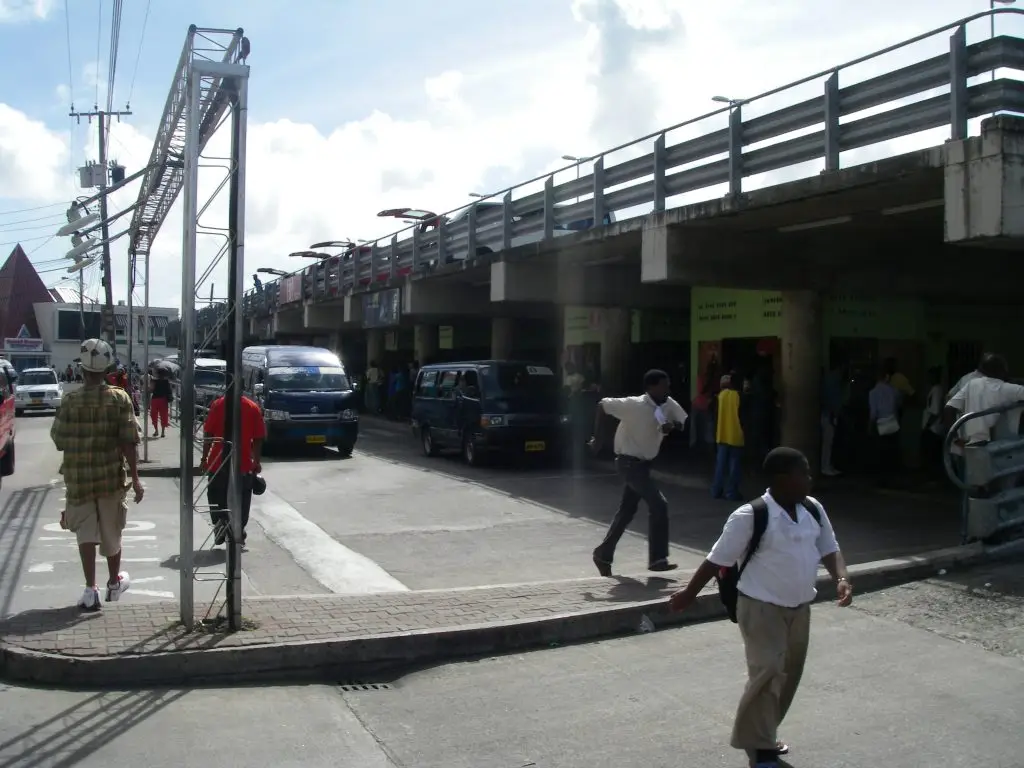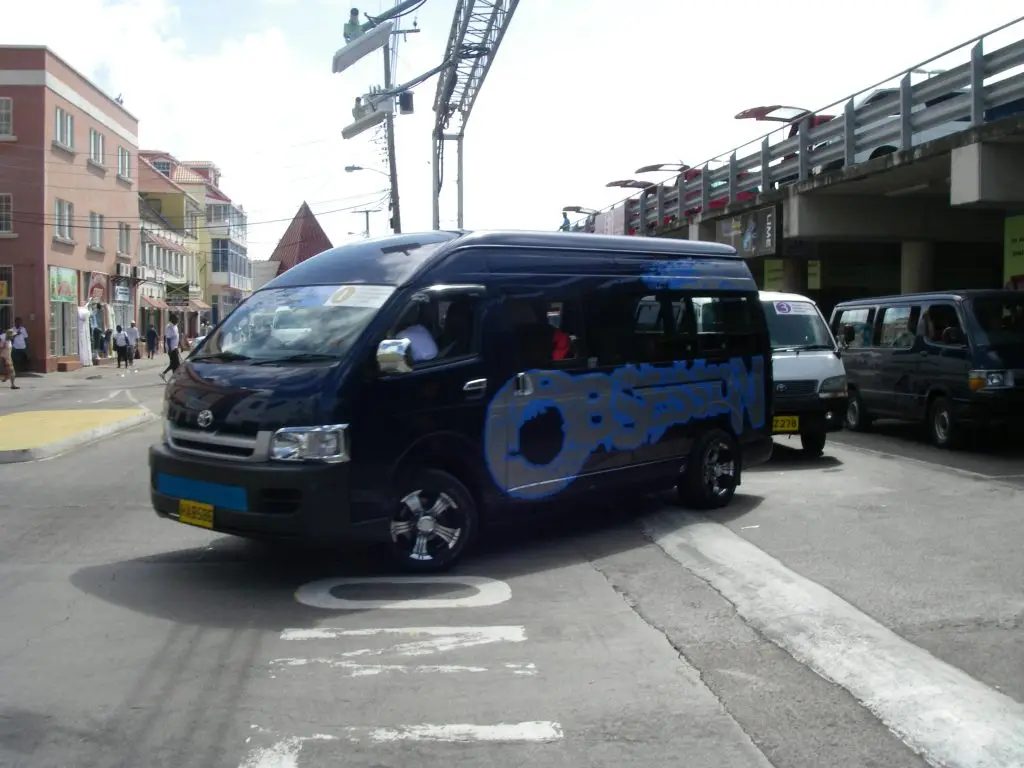Drive It Like You Stole It
by
James Ewing
It’s a scene straight out of a movie. The rickety bus pulls up to the curb, the door opens, and a cloud of fragrant smoke issues forth. You, The Unsuspecting Passenger, squeeze into the last 8-inch space available. The dreadlocked driver turns, lowers his sunglasses, and winks. Wheels wobbling the bus turns the corner and, belching fumes, accelerates up an insanely steep street. Pedestrians, pets and purveyors of fruit are swept out of the way. The windshield clears – nothing but blue sky ahead. A sharp left onto a road painted along the knife edge of an ancient crater – cliffs down to the sea on one side and into the jungle on the other. Swerving around chicken trucks on blind corners the bus finds speed you didn’t think it could possess. Cresting a rise, all four wheels in the air, the bus rockets away – like it was shot out of a gun.
These are the buses of the Caribbean Islands. Forget the taxis, forget the tours, forget about renting a car. If you are cruising in the islands the local bus system is the only way to travel. The service goes by different names on different islands: “The Bus” on most of the former English islands, “Maxi Taxi” in Trinidad and Tobago, and the oh-so-Gallic “Taxis Collectifs” on the French Islands. Whatever the name they all work pretty much the same.

The vehicle is – usually – a mini-bus. Occasionally you’ll see something along the line of an airport rental car shuttle bus, but not often. The bus is rated to hold something between “15 and 19” people. The bus is privately owned and operates along a “fixed” route. Sometimes there’s a conductor to open the door and take the fare from you. Conductors make the whole process run smoothly and efficiently. They also hustle passengers and let the driver know if a potential fare is sighted. The flip side is that the conductor takes up a “seat” that could be sold and the driver doesn’t make as much money when he cuts earnings with the conductor. There are no conductors on the French Islands.
The process is similar everywhere but the details vary from place to place. I’ve been in Grenada for the past five months and this is how it works there. To get a bus you just go to the street. If you’re walking a bus will screech to a halt and ask you if you need the bus. If you are just standing there a bus will screech to a halt and ask if you need the bus. If you are walking down a side street a half-mile off the route a bus will screech to a halt, throw it into reverse and back that half-mile up to you and ask if you need the bus. The question is asked by the conductor. He jabs his arm out the window and makes a sign not unlike Mr. Spock’s “live long and prosper” thing. If you want the bus you make a similar sign pointing downward. If you don’t want the bus you either make a downward-pointing “no-no-no” sign with your finger or shake your head. These “no, thanks” signs must be done the way a bronze statue would do them. Anything more demonstrative will be mistaken as the “yes” sign and the bus will stop.
.
Or you can go to the Terminal. There are always buses at the terminal. There is no rush to get on the bus. You can make sure you get on the right bus and there’s plenty of time to load your shopping in with you. The Terminal is also the only place the driver is guaranteed a “full load” of passengers. The bus doesn’t leave until it’s “full”. Welcome to Bus Arithmetic. The smaller buses are rated for 15 passengers – four rows of three plus three in the front seat, the larger are set for 19 – Four rows of four plus three up front. The fixed seats are filled first then flip-down seats are used to fill what used to be the aisle. When all the seats are full – if you’re lucky – the conductor gets out cushions to fit across the gap between the fixed seat and the fold-down. If you’re unlucky you are stuck with “seat sharing” which is also known as “sitting on someone’s lap”. Eventually the bus, now full beyond capacity and belief, departs with a happy driver up front and a surly mob in the back.

So, what do you get for this pittance of a fare? You get a ride on one of the safest, most efficient, cleanest and downright fun forms of public transit anywhere in the world. On average the bus you want will pass the place you are standing every few minutes or so. The longest I’ve ever had to wait for a bus – this was on a day when the buses didn’t run and on a route that was well off the beaten track – was 20 minutes. Typically there will be a bus waiting for you when you get to the street. If you need to go off the “fixed” route it’s usually no problem. The buses will make detours and side runs – often at no charge – for school kids, little old ladies with groceries, local workers, anybody. Including you. Just ask. If you don’t know where you need to get off tell the conductor where you’re going and they’ll make sure you get the right stop. This really is the only way to get around when visiting the Islands.
But what about that Hollywood image? The reality of course is much different. The drivers – not all sporting dreads – are skilled, tested and re-tested, and carefully monitored. The wobbly conveyance of the movies is, in reality, a well-maintained and meticulously detailed vehicle. You don’t see breakdowns and you almost never see or hear about accidents. The movie image is preserved only in the names on the buses: “No Fear”, “Golden Touch”, “Super Sonic”, “Outta Time”. These are rides with an attitude – cool and fast. Gleaming paint jobs sport high-tech graphics that look like they were stamped out of hot metal and riveted in place or splashed on in dribbling perfection straight from the can. Sound systems play Reggae, Soca, or Calypso through premium speakers. At night the inside of the buses get painted with custom LED lighting that just screams cool. Disney couldn’t even come close.
My favorite route in Grenada is the Number 4 to from St. George’s to St. Paul’s. The bus leaves the terminal packed with 17 trusting souls, the driver, and conductor. A left turn on the insanely steep St. John’s Street and the bus accelerates up the hill. Pedestrians, dogs, and vendors squeeze out of the way. Another left on Church Street – nothing but blue sky through the windshield – the engine whines as the driver speeds on, grabbing gear after gear. Further up the hill on Lucas Street the bus finds speed you didn’t think it would possess. Now you’re through the roundabout and flying along a road that seems like it was painted along the rim of an ancient volcano. The bus crests a rise, all four wheels stuck firmly to the pavement, and rockets away – like it was shot from a gun.

.
